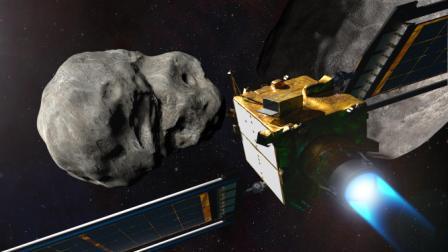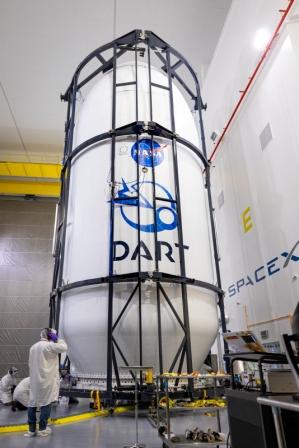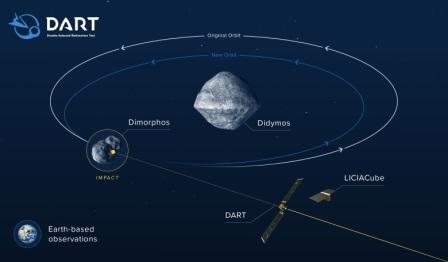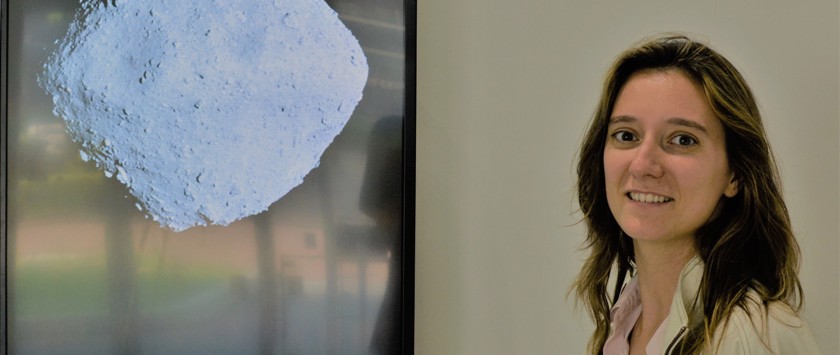Saving the planet isn’t exactly what Stefania Soldini imagined she’d be doing when she began her Masters in Space Engineering but it has effectively become her everyday reality. When she joined the University of Liverpool in 2019, as Assistant Professor in Space Engineering in the Department of Mechanical, Materials and Aerospace Engineering, Stefania had already been ‘behind the wheel’ of a satellite tracking a near-earth asteroid.
“I never set out to work in planetary defence specifically,” says Stefania. “But I was fascinated by trajectory design for satellites and planning space missions, so after the end of my PhD, in 2017, I went to work for JAXA (The Japan Aerospace Exploration Agency). Their hot topic mission at the time was an asteroid mission called Hayabusa2, and I actually got to work with the flight dynamic team as engineer and do mission operation on the satellite, which was very cool. From that moment on, my research all changed in that direction.”

Image copyright NASA/Johns Hopkins APL
After her work on Hayabusa2, which successfully surveyed asteroid Ryugu for a year and a half, sent out operating rovers to explore the asteroid surface, and collected material samples, Stefania joined the European Space Agency (ESA). Today, she is part of the ESA and NASA teams working on two seminal - and interconnected - asteroid missions: Hera and DART. If you haven’t heard of the latter, what planet have you been on?
A seminal space mission
In a real-life version of the science mooted in satirical Hollywood movie Don’t Look Up, NASA’s Double Asteroid Re-direction Test (DART) mission sent a spacecraft to smash straight into an asteroid.

Image copyright NASA/Johns Hopkins APL
The fridge-sized spacecraft (pictured above) was launched in November 2021 and collided with the target asteroid Dimorphous (the moonlet of the larger asteroid Didymos) in September 2022. While neither asteroid ever actually posed a threat to Earth, the successful deflection is hugely significant. NASA described it as “humanity’s first time purposely changing the motion of a celestial object and the first full-scale demonstration of asteroid deflection technology”. The success of the mission suggests that the technique could really be used to help protect Earth from a collision with an asteroid, if we ever did discover one headed straight for us.
An unexpected outcome
Since DART hit the headlines, Stefania has been occupied looking at how effective this deflection technique is and also, what the implications are of the ejecta which was detected after the impact. As well as helping Stefania’s teams to analyse the composition of the asteroid, this loose material which lifted off the surface of the moonlet in plumes is evidence that the mission did more than change the direction of the asteroid. “The impact was enough to lose a considerable amount of material from Dimorphous,” explains Stefania. “That’s more than hitting the surface, it shows additional momentum. We gave it an extra kick!”

“Our minimum expectation was to change the trajectory of the moonlet asteroid’s orbit by 73 seconds but we actually changed it by more than 30 minutes. This was far more successful than we had ever imagined.”
Of course, this all came at a price. A large-scale mission targeting a single asteroid involves huge expense and many years of research, development, design and preparation. Looking to the next generation of planetary defence, Stefania is championing a move towards a smaller scale approach using mini self-driven satellites.
Tiny solar explorers
“The idea is to use a swarm of micro satellites, known as CubeSats, which would be sent out into the solar system to autonomously track and explore multiple asteroids at the same time,” she explains. “The goal would be to gather information to create a database of the asteroid population, so we know their properties, and more precisely what to do, should any of them become hazardous for our planet.”
In 2022, Stefania was awarded a UKRI-funded Future Leaders Fellowship, to lead research into the development of these CubeSats, which could help mitigate against future risks to the Earth from asteroids. “DART is our first step towards trying to do something in space that works,” says Stefania. “There is much more to be done, both with regards to exploring deflection, and other techniques, to make sure we are ready for different case scenarios.
“The composition of an asteroid and the length of time you have before it becomes hazardous will ultimately determine which technique is the most efficient.” With her swarm of satellites, Stefania hopes to gather this precise information on the asteroid population, so that we are, quite literally, ready for anything. ●
The impact was enough to lose a considerable amount of material from the asteroid. That’s more than hitting the surface, it shows … we gave it an extra kick!
Dr Stefania Soldini
